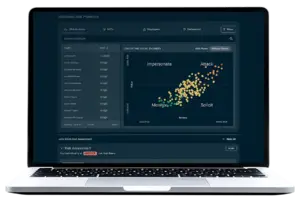Chief Information Security Officers (CISOs) are like sailing captains navigating their organizations through treacherous waters. The threats are ever-changing, and the stakes are incredibly high. Shifting winds sometimes originate from within the organization’s top leadership, not just from external events, and CISOs must keep adjusting the sails to move forward despite shifting business priorities and resource constraints.
The response to the constant flow of security incidents hitting a vulnerable attack surface creates a sense of inevitability that someday the ship will sink. More often than not, being a CISO must feel like sailing a boat constantly springing new leaks that need to be detected and plugged as quickly as possible while running water pumps to keep the ship afloat and moving forward. It’s a hazardous and challenging job, and there’s little room for complacency. There is no question that the role isn’t for everyone. It takes a sailing captain’s wisdom and courage to face the odds.
Traditionally, many CISOs have relied heavily on reactive security measures—those implemented after an attack has occurred or is underway. However, as cyber threats become more sophisticated and the human element continues to be the single largest attack vector and security risk, the need for a proactive approach to security is becoming increasingly apparent. This shift from detection and response to prevention is not just a strategic advantage but an imperative in today’s AI-powered threat landscape.
Understanding Reactive vs. Proactive Security Controls
Reactive Security Controls
Reactive security controls are measures implemented in response to a security incident. These controls aim to detect, respond to, and recover from attacks. While essential, they often come into play only after damage has occurred, making them less effective at preventing breaches. Moreover, reactive controls are rarely adaptive as they are designed to detect the same type of attacks repeatedly.
Examples of Reactive Security Controls:
- Intrusion Detection Systems (IDS): IDS monitor network traffic for suspicious activity and alert security teams to potential intrusions. However, they act only after an attack attempt has begun.
- Incident Response Plans: These are like emergency protocols in a crisis. They are predefined procedures for addressing security incidents. While crucial for mitigating damage, they are implemented post-incident, focusing on containment, eradication, and recovery.
- Endpoint Detection and Response (EDR): Advanced endpoint protection solutions are like having guards at every entrance. These include features like threat intelligence, behavioral analysis, and automated response that can identify and neutralize threats before they cause harm. Most recent solutions include AI-powered capabilities that utilize deep learning to prevent malicious code from infecting endpoints. However, endpoint protection is reactive to attacks; it does not remove conditions for attacks to begin in the first place.
- Security Information and Event Management (SIEM): SIEM systems collect and analyze log data from various sources to identify and respond to security incidents. They provide valuable insights but are primarily reactive, dealing with events after they occur.
- Digital Forensics: Post-incident analysis to determine the cause and impact of a breach helps improve future defenses but is inherently reactive as it takes place after the incident.
- Backup and Recovery Solutions: Ensuring that data can be restored in the event of a ransomware attack or data loss is critical to ensure resilience and business continuity. However, backups are used after an incident has already compromised data integrity.
- Security Awareness Training: Imagine your employees as a line of defense. Educating them about cybersecurity best practices, social engineering attacks, and phishing scams can significantly reduce the risk of human error. Regular training sessions and simulated phishing exercises ensure that staff remain vigilant and informed. However, this training teaches people how to identify and react to social engineering attacks; they don’t prevent attacks. Besides, relying on executives and employees to make constant security decisions will always be a losing battle against threat actors.
This was not an exhaustive list, but it does provide illustrative examples of reactive security controls.
Proactive Security Controls
Proactive security controls are like a sonar or radar that uncovers hidden obstacles ahead to avoid them. Or like satellite imagery that helps update the weather forecast along a navigation route. These controls are all about foresight—anticipating potential attack pathways to prevent attacks from happening in the first place, and if they do, be prepared to detect them and respond swiftly with reactive controls in the right places. Organizations can protect their assets, data, and reputation by identifying and mitigating risks in advance.
Examples of Proactive Security Controls:
- Vulnerability Management: Think of this as regularly inspecting and reinforcing your ship’s hull to make sure you keep your people inside and the water outside. Scanning for and patching vulnerabilities in software and hardware systems helps prevent exploits. By maintaining an up-to-date inventory of assets and applying patches promptly, organizations can close potential entry points for attackers. A continuous threat exposure management program helps reduce and protect the technical attack surface. While it won’t be able to avoid zero-day vulnerabilities, it reduces the technical attack surface.
- Network Micro-Segmentation: Picture a double-hulled ship with multiple water-tight bulkheads that create multiple layers of water containment in the event of a hull breach. Dividing a network into smaller, isolated segments can limit the spread of an attack. This containment strategy ensures that if one segment is compromised, the attacker cannot easily access the entire network. Network micro-segmentation policies, especially identity-based ones, can effectively enable least-privilege access and prevent lateral movement. By isolating users, devices, and applications from other users, devices, and applications they shouldn’t communicate with, micro-segmentation creates a rugged terrain for the attacker that slows their progress toward their ultimate objective, giving defenders more time to detect and respond. While network segmentation does not prevent attacks and initial access, it does limit lateral movement and, thus, the blast radius of an intrusion.
- Multi-Factor Authentication (MFA): Imagine a double-locked door requiring multiple keys to open. Requiring multiple forms of verification before granting access to systems and data adds an extra layer of security. MFA significantly reduces the risk of unauthorized access even if passwords are compromised. It is not foolproof, though: MFA bombing and sim swap attacks are a type of social engineering attack that aims to bypass this control by preying on human vulnerabilities.
- Human Attack Surface Protection (HASP): The king of proactive security, HASP removes conditions for social engineering attacks, making it more difficult and costly for threat actors to breach an organization through its people. Also described as Digital Risk Protection Services by Gartner and Human Risk Management by Forrester, Picnic coined the term HASP because we took the category beyond specific use cases and blended them into a combination of tech-enabled services that deliver risk remediations that lower the probability of breaches. HASP provides defenders with visibility through the lens of the social engineer and delivers control by removing users from security decision-making. It enables continuous social engineering threat exposure management and informs security tools downstream of the attacker’s kill chain.
This was not an exhaustive list, but it does provide illustrative examples of key proactive security controls. Look at the above list and ask yourself: where is my security gap? What’s my blind spot? Most security-mature organizations will consider their human attack surface, not the technical one, as their main weakness area.
The Growing Threat of Social Engineering Attacks
Social engineering attacks are the most prevalent and dangerous forms of cyber threats. These attacks exploit human psychology rather than technical vulnerabilities to gain access to sensitive information or systems. Common types of social engineering attacks include bulk phishing, spear phishing, smishing, vishing, pretexting, baiting, and whaling, among many others.
In October 2019, Jen Easterly, Director of CISA, gave a presentation to Engineering Capital when she began her keynote by stating that more than 90% of all cyber attacks rely on open-source intelligence (OSINT). Would-be attackers typically conduct reconnaissance of their human targets’ digital footprints to plan and execute social engineering attacks. According to the 2023 Verizon Data Breach Investigations Report, social engineering attacks account for 22% of all data breaches. Furthermore, a study by the Ponemon Institute found that the average cost of a social engineering attack for a company is approximately $1.6 million. These statistics highlight the significant risk posed by social engineering and the need for effective proactive security measures to combat these threats.
The Role of Picnic Human Attack Surface Protection Services in Defending Against Social Engineering
 Proactive security controls are crucial in defending against social engineering attacks, as these threats often bypass traditional technical defenses. The human attack surface—comprising employees, contractors, and partners—is often the weakest link in an organization’s cybersecurity defenses. HASP services are essential for safeguarding this vulnerable security aspect. HASP involves monitoring and mitigating threats that exploit human weaknesses and digital channels.
Proactive security controls are crucial in defending against social engineering attacks, as these threats often bypass traditional technical defenses. The human attack surface—comprising employees, contractors, and partners—is often the weakest link in an organization’s cybersecurity defenses. HASP services are essential for safeguarding this vulnerable security aspect. HASP involves monitoring and mitigating threats that exploit human weaknesses and digital channels.
Key Features of HASP Services:
-
 Continuous Social Engineering Threat Exposure Monitoring and Analysis: HASP services continuously monitor digital channels, including social media, data brokers, dark web forums, and online marketplaces, for exposed personally identifiable information and credentials that can be used to target the organization with social engineering techniques. This proactive surveillance helps identify, analyze, and neutralize human risk before it materializes into attacks. This includes:
Continuous Social Engineering Threat Exposure Monitoring and Analysis: HASP services continuously monitor digital channels, including social media, data brokers, dark web forums, and online marketplaces, for exposed personally identifiable information and credentials that can be used to target the organization with social engineering techniques. This proactive surveillance helps identify, analyze, and neutralize human risk before it materializes into attacks. This includes:
- Ability to discover someone’s entire digital footprint from one data point
- Ability to disaggregate the John Smith problem
- Ability to continuously discover changes in digital footprint
- Ability to remove data in the wild to reduce digital footprint
- Ability to convert raw data into finished human risk intelligence (i.e., risk scores, threat maps)
- Digital Executive Protection: Coordinated and advanced social engineering attacks often target high-profile executives. HASP provides enhanced protection for these individuals and their families by monitoring their digital footprint and mitigating risks associated with their online presence. This service accounts for their personal digital identities while respecting privacy through a privacy-by-design approach. It is enhanced by adding personal device protection and tailored cyber awareness coaching.
Cyber risks can translate into physical threats, and HASP is a proactive way to prevent them. Exposure for these individuals is often necessary and inevitable as they are often considered brand assets. The key is reducing the unnecessary and unwanted digital footprint to the point where it is no longer a critical risk liability, and by hardening what needs to remain public.
- Credential Monitoring: HASP includes monitoring for compromised credentials on the dark web and other illicit forums. Early detection of exposed credentials allows organizations to take immediate action to secure accounts and prevent unauthorized access.
For example, Credential Monitoring enables automatic protection against credential stuffing attacks, one of Picnic’s key differentiators. Either by native integration with Active Directory or via API, Picnic can continuously disallow breached personal and work passwords, current and former, to be reused within the organization, effectively neutralizing credential-stuffing attacks.
- Integrations with Security Controls: The HASP platform that Picnic has developed and uses to deliver proactive protection services offers the ability to integrate with existing security tooling to drive real-time changes to security risk posture. Whether via API or native integrations, leveraging real-time human risk intelligence boosts the performance of your overall security program by identifying and prioritizing the most likely human targets of social engineering attacks. Some of the features include:
- Ability to notify employees of changes to their individual risk as a way to increase awareness of the problem
- Ability to combine human risk intelligence with other intelligence feeds (Threat Intelligence, Vulnerability Scanning, Endpoint Telemetry) to see more of the threat landscape
- Ability to leverage human risk intelligence to more accurately detect fraud, deepfakes, impersonation, and similar attacks
- Ability to prevent attacks by predicting who will be targeted and how they will be targeted before the attack happens
The Case for Shifting to Proactive Security
Cost-Effectiveness
Investing in proactive security measures can lead to significant cost savings in the long run. The cost of recovering from a breach—including incident response, legal fees, reputational damage, and potential regulatory fines—can far exceed the cost of implementing preventive measures. By preventing incidents before they occur, organizations can avoid these substantial costs.
Protecting Reputation and Trust
A data breach can severely damage an organization’s reputation and erode customer trust. In an age where data privacy is paramount, maintaining a strong security posture is crucial for preserving the trust of customers, partners, and stakeholders. Proactive security measures help ensure that sensitive data remains protected, bolstering an organization’s reputation as a trustworthy and reliable entity.
A Complex and Expanding Threat Landscape
Cyber threats are evolving at an unprecedented rate, with attackers employing increasingly sophisticated methods to breach defenses. Traditional reactive measures are no longer sufficient to protect against these advanced threats. By the time an attack is detected and responded to, significant damage may already have been done. Proactive security measures, by contrast, aim to stop threats before they can cause harm, making them essential for modern cybersecurity strategies.
How CISOs, CSOs, and Chief Risk Officers Can Lead the Shift to Proactive Security
- Develop a Security-First Culture: Promote a culture of security within the organization by emphasizing the importance of proactive measures. Encourage all employees, including the executive leadership, to take responsibility for cybersecurity, making it a shared priority. While it is not an easy feat, showing them the value of HASP can be a game changer as it makes cybersecurity personal by blending corporate security with personal security. “Safe at home, safe at work.”
- Leverage Threat Intelligence and Risk Intelligence (Target Intelligence): Utilize these to stay informed about emerging threats and vulnerabilities. This information can guide the implementation of proactive measures tailored to the organization’s specific risk profile.
- Adopt a Risk-Based Approach: Focus on identifying and mitigating the most critical risks to the organization. Conduct regular risk assessments and prioritize proactive measures that address the most significant threats. A focus on human risk can pay off very quickly, as it can be easily outsourced to subject matter experts and can provide value almost immediately.
- Invest in Advanced Technologies: Deploy advanced security technologies such as artificial intelligence (AI) and machine learning (ML) to enhance threat detection and prevention capabilities. These technologies can identify patterns and anomalies that traditional methods might miss. If your attackers are investing in AI, so should you. It’s AI vs. AI out there these days, and it will get more intense as the technology evolves.
- Continuously Improve Security Posture: Regularly review and update security policies, procedures, and controls to adapt to the evolving threat landscape. Proactive security requires ongoing vigilance and adaptation to remain effective. It is a never-ending process geared to lower your organization’s risk profile below its tolerance level and keep it there.
Conclusion
As the cyber threat landscape accelerates the pace of its evolution, the need for proactive security measures has become a strategic imperative. CISOs need to team up with CSOs and Chief Risk Officers to lead the charge in shifting from reactive to proactive security strategies, focusing on prevention rather than just detection and response. Organizations can better protect their assets, reduce costs, and maintain their customers’ and stakeholders’ trust and confidence by implementing proactive security controls such as HASP.
The future of cybersecurity lies in anticipating and preventing threats before they occur, and proactive security is the key to achieving this goal. Securing the human element is key to bolstering overall defenses, as it is the single largest attack vector and security risk in every organization. The key to success with proactive security is to remove users from everyday security decisions, which can only be achieved with full visibility into the human attack surface and risk-informed security controls. Sailing captains avoid bad weather.
About Picnic
Picnic’s Privacy as a Managed Service for Enterprises protects those executives, employees, and contractors that threat actors will consider high-value targets of social engineering attacks. Picnic uses its proprietary technology to identify and analyze human risk and deliver prioritized remediations proactively and continuously without any effort on the part of the customer.
